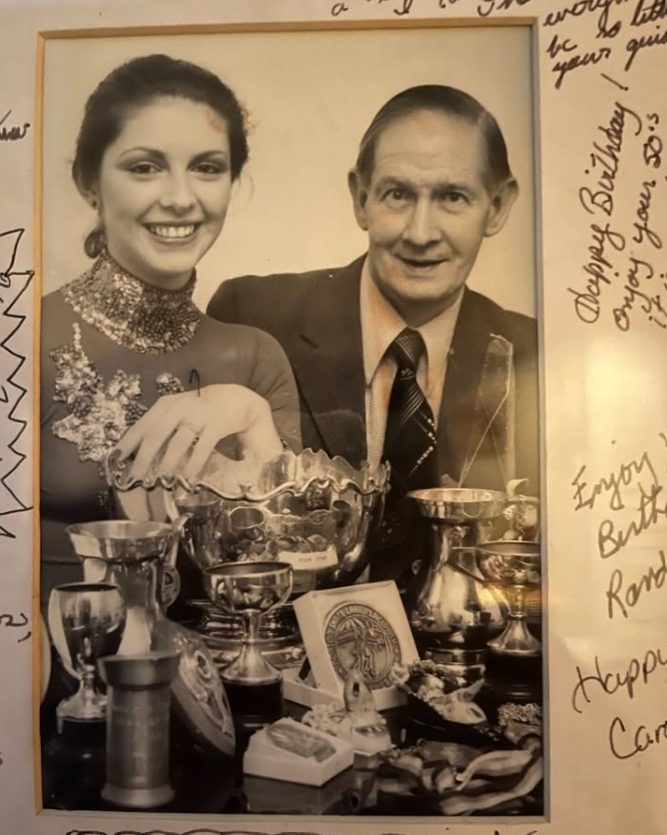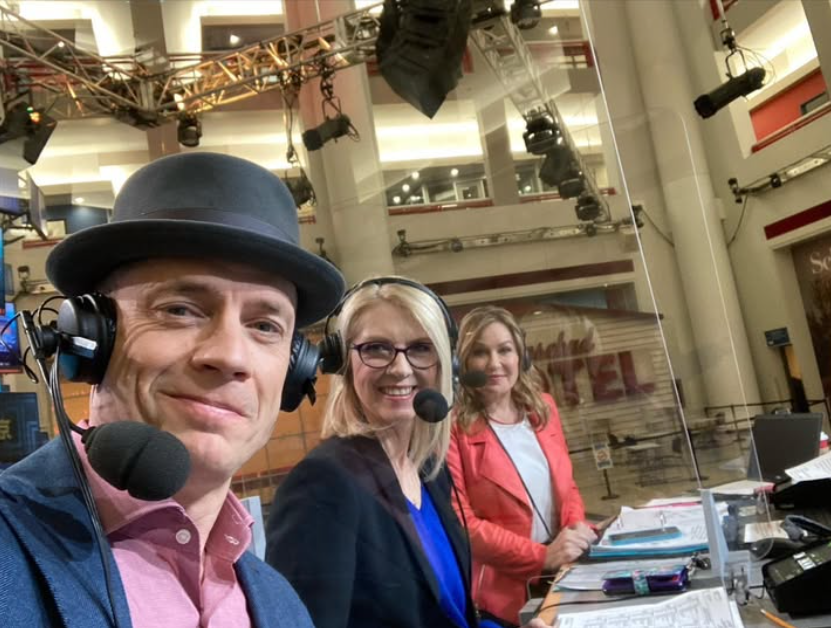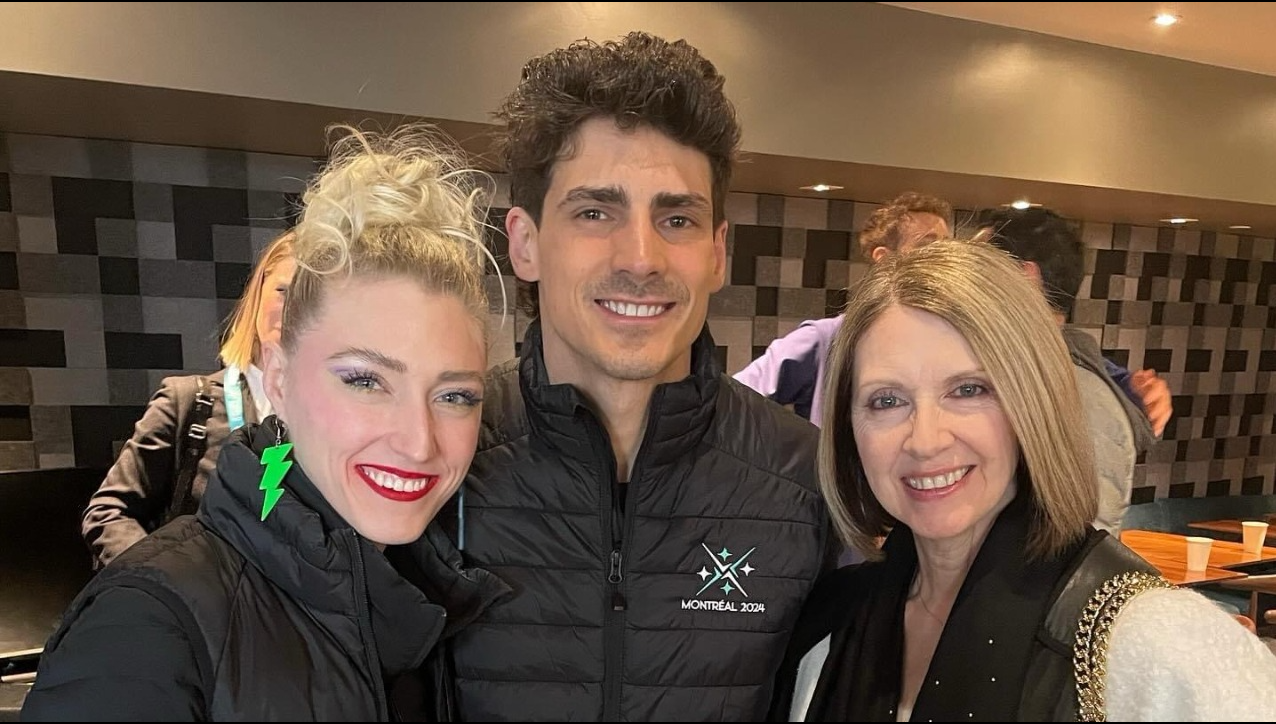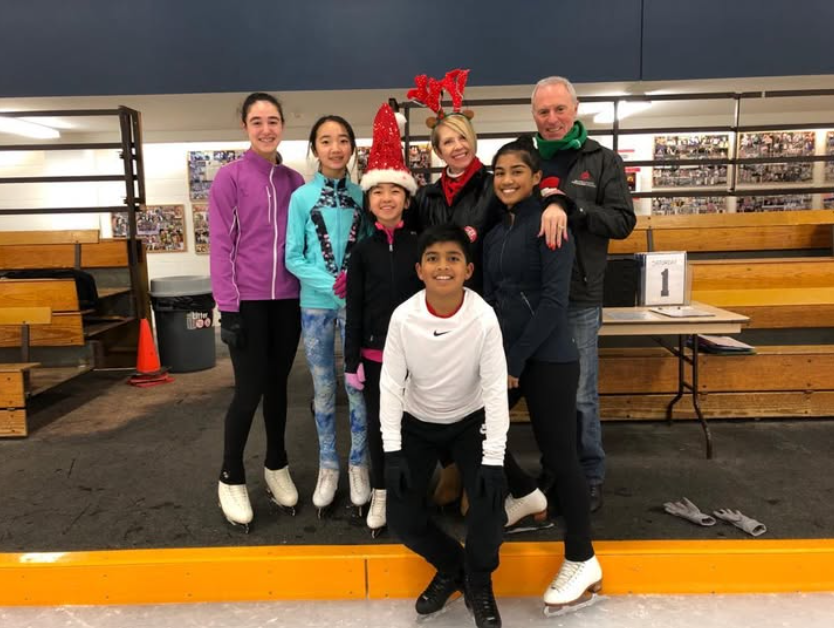welcome-home-blog-by-debbi-wilkes
Olympic Ice Dance Coach Carol Lane began her skating journey thousands of miles from Canadian shores.
Born in London, England to parents Joan and John Long, Carol was given lots of opportunities to develop her talents. “My parents enrolled me in everything … drama, piano lessons, I played the cello, even horseback riding … basically anything I wanted to do. They were my big supporters but it was my Mum who took me everywhere.”

Carol and her father John Long. Photo Credit: Carol Lane on Instagram
It was the 1960’s.
Carol was 7 when she asked her Mum one weekend if they could either go skating or to the cinema. “My Mum chose skating as maybe the lesser of two evils,” laughs Carol, “of course having no idea how that one decision would eventually change our lives.”
Carol’s first steps on the ice would be in brown skates rented at the Streatham Ice Rink in South London. “I was rather a late starter,” admits Carol. “My sister Sally, 16 years older than me, claims she was the first person to take me skating.” But that first day, Carol remembers both her Mom and Dad were there for support … although she was not happy about having to wear brown skates!
“My Mom advised me to hold on to the barrier, as we call it, but I just took off. I was gone! It never occurred to me that I couldn’t do it.”
In those days in Britain, skating was organized around three sessions a day, morning, afternoon and evening. “Basically, anyone could skate,” says Carol. “Sometimes it was busy, sometimes not … but the middle of the rink was always taken up by the good skaters doing fancy stuff.”
The big deal for Carol was that every session also included at least one dance interval. “Everyone had to clear the ice for the dancers … there was live music played by John Bowery, an organist … it was wonderful!”
At first Carol watched all of this at one end of the rink overlooking the ice surface either from the Grillette Cafeteria or from the Milky Way Ice Cream Bar along the side. As she became more familiar with the dances, she was determined to join in… until her Mum grabbed her. “Why can’t I go on? I can do that dance!” Carol remembers it was the Blues, to this day one of her favorite dances.
With Carol’s interest growing, her Mum signed her up for the rink’s skating classes called Young Blades where you earned badges. Carol proved to be a quick study, although when she became frustrated trying to learn a turn, it was time for private lessons, the next step in her progress.
“The British system was very different from Canada’s,” states Carol. “You had to book your lesson through a ‘lesson desk’ where you’d get tickets to hand in to your coach after each lesson. At the end of the week they would hand them in to the rink to get paid.”
Carol’s coach was none other than Peri Horne, celebrated international competitor and, along with many-time World Dance Champion Courtney Jones, half of the team to invent the Starlight Waltz and the Silver Samba.

Photo Credit: Carol Lane on Instagram
“Apparently I progressed very quickly,” recalls Carol, “and soon I was skating on the Saturday sessions where there were games and races, live music and sometimes live singing.” But it meant leaving home by 5 am off with her Mum to the bus station.
During the break between sessions, Carol and her Mum would join the other skaters and their families at a café called The Chimes. “We’d have breakfast … bacon and eggs, baked beans and toast. A whole gang of little boys and girls hung out together.”
Early competitions for Carol were in free skating. “I was a terrible free skater,” says Carol. “I remember competing in the Wembley Novices, where if your music ran over the time, you got gonged out!”
Although Carol was loving skating, the big draw was participating in the dance interval. “I taught myself almost all of the dances … both the women’s and men’s steps … so I could skate and dance with my friends. I didn’t even mind being the ‘guy’.”
As long as she could dance, Carol was happy.
“I loved being able to attach movement to music,” says Carol. “I was that horrible child who would skate to everyone else’s solo music … actually my first solo was to ‘Puppet on a String’. When other music would start, I’d rush to centre ice, strike a pose and away I’d go. In hindsight, I was doing choreography and making stuff up right from the beginning.”

Carol Lane, Piper Gilles and Paul Poirier
Carol also had another source of inspiration. “Of course there was no Internet back then but we did have Saturday afternoon movies, often big Hollywood musical productions on the TV … and I would just sit there and take it all in. Seven Brides for Seven Brothers, Singin’ in the Rain, Brigadoon … I grew up with all of those.”
There was always music in the Long household too. Although Carol’s Mum was not musical at all, her Dad made up for it. “In his younger days, my Dad played the piano for silent movies … he was self-taught and played everything by ear.”
Carol feels they were the perfect skating parents … supportive but not interfering. “My Mum would give me hell if she thought I wasn’t working hard enough,” says Carol. “My Dad, on the other hand, only ever asked two questions: Did you have a good skate today? Did I have a shoot-the-duck or teapot in my program?” (To this day, as a little nod to her Dad, almost every program Carol creates has some form of a shoot-the-duck in the choreography.)
From here, Carol’s skating future began to take shape, including making some tough decisions about changing coaches and training facilities. Her focus became about passing tests, forming dance partnerships, and competing, first with Graham Payne, then with Philip Stowell, and finally with John Philpot, all under the watchful eyes of coaches like Jon Lane and Vivian Dean and later Gladys Hogg.
When Carol ultimately retired from competition, she turned her attention to coaching, building on her past experiences and learning from some of the greats, including the legendary Bobby Thompson.
“When Bobby was invited to Canada to guest coach at the Ice Dance Centre of Ontario, he was looking for an assistant and asked me if I would join him. Would I? Would I!!”
Carol was thrilled … and launched herself into a whole new Canadian adventure.
“I was blown away by how amazing it was! We had nothing like that in England. You weren’t allowed to have another coach … another coach couldn’t even look at you. You were not allowed to go into another rink … you had to get special permission. It was a whole big deal. You were just in your little pond, and that was it.”
The experience in Canada was transformative for Carol. “My skating career has been spent trying to recreate that atmosphere … that sense of camaraderie, of people coming together, of feeling like you were important and part of a family.”

Photo Credit: Carol Lane on Instagram
In the meantime, Jon Lane would re-enter Carol’s life. And in the ensuing years, they would both make the trip to Canada to coach in the summers. “I already knew after the first year that this was where I wanted to be,” admits Carol. “I just fell in love with Canada!”
There were a lot of adjustments for the new couple. Thinking back, Carol remembers, “We were strangers in a strange land … and we owe thanks to so many wonderfully supportive Canadian coaches and particularly to those who took us on at the Silver Blades Skating Club.”
Today, with one of the most vibrant and successful ice dance schools in the country, Carol knows it was all worth it.
“I think the biggest thing that Canada gave us was the opportunity to learn.”
And underscoring all of her achievements are her Dad’s words of advice …
“Carol, I’ve worked for the same company until I retired. And in that time I’ve never said a dishonest word or taken a dishonest penny from anybody. If you can get to the end of your career and say the same thing, then I will be happy.”
For Carol Lane, it’s been her guiding principle.
Previous Post
Member Spotlight: Kenora Skating AcademyNever Miss an Update
Be the first to know about upcoming Skate Ontario events and special updates—subscribe today!
By submitting this form, you are consenting to receive marketing emails from: . You can revoke your consent to receive emails at any time by using the SafeUnsubscribe® link, found at the bottom of every email. Emails are serviced by Constant Contact


